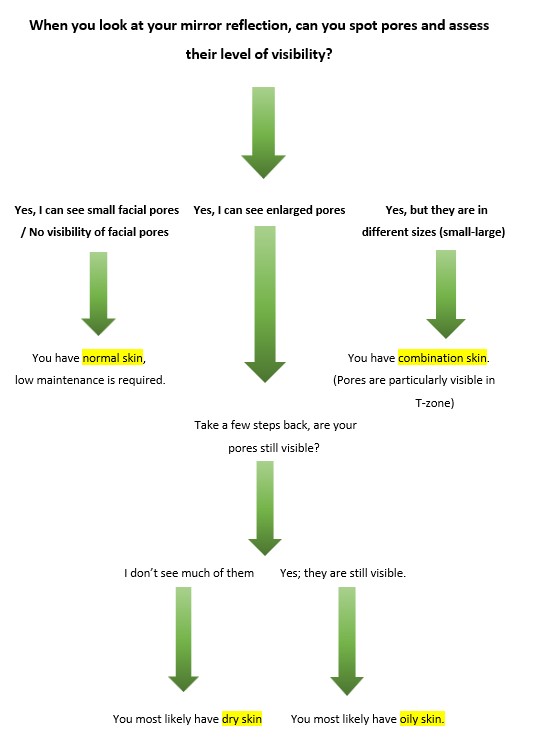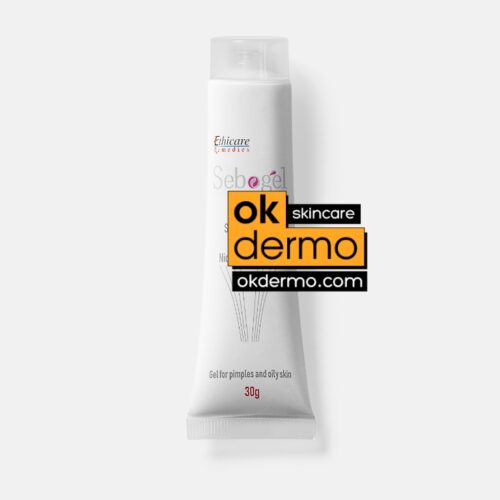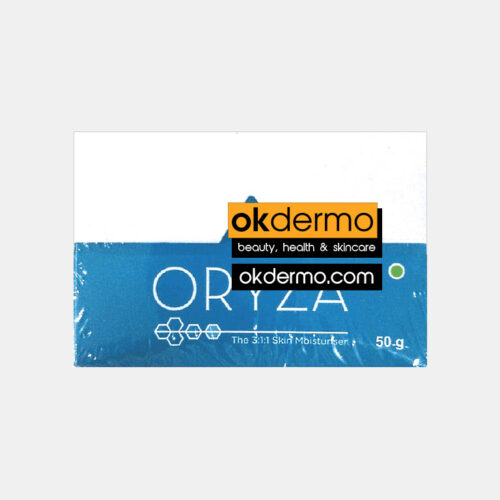How To Determine Your Skin Type
Table of Contents
Ever wondered why a skincare routine that works wonders for someone else seems to fall short for you? The answer lies in understanding your skin type, a fundamental step that is often overlooked by many skincare users.
The significance of knowing your skin type goes beyond cosmetics – it’s about tailoring your skincare routine to your skin’s unique needs.
To keep you on top of your skincare game, we have prepared this guide with particular attention on this matter making it easy for you to understand how to determine the skin type you have and achieve rejuvenated skin with personalized skincare choices.
Why should I know my skin type?
The impact of skin type on skincare choices cannot be overstated. Just as we wouldn’t use a one-size-fits-all approach to clothing, our skin deserves a personalized regimen.
Furthermore, products that don’t address your skin type and specific concerns are not only a waste of money, but they also make existing concerns worse, for example, they can cause breakouts, worsen blemishes, or cause redness.
Therefore, understanding your exact skin type allows you to choose products with precision that have the real potential to work wonders for your skin.
Basics of Skin Anatomy
First, Let’s understand the basic anatomy of your skin that is crucial for effective skincare. Your skin consists of three main layers: the epidermis, dermis, and subcutaneous tissue. Each layer plays a vital role in maintaining your skin’s health and appearance.
Epidermis:
- Outermost layer.
- Protects against the environment.
- Consists of multiple sub-layers, including the stratum corneum (dead skin cells) and the basal layer (new cell formation).
Dermis:
- Below the epidermis.
- Provides structural support.
- Contains blood vessels, nerves, and connective tissue.
- Houses hair follicles and sweat glands.
Hypodermis (Subcutaneous Tissue):
- Deepest layer.
- Composed of fat and connective tissue.
- Acts as insulation and a cushion.
- Connects skin to underlying muscles and bones.
The Role of Sebaceous Glands
Sebaceous glands, scattered throughout the skin, produce sebum, an oily substance that lubricates and waterproofs the skin. Understanding the role of these glands is key to comprehending your skin type.
Overactive sebaceous glands may result in oily skin, while insufficient sebum production can lead to dryness.
Balancing the activity of sebaceous glands is crucial for maintaining healthy skin. Tailoring your skincare routine to regulate sebum production ensures that your skin remains hydrated without being excessively oily or dry.
How to determine the skin type I have?
There are generally five common skin types, each with its own characteristics and care needs:
- Normal Skin: Normal skin is the gold standard, characterized by balanced hydration, minimal imperfections, and a radiant complexion. Pores are usually small, and the skin feels neither too oily nor too dry. If you often receive compliments on your skin’s clarity and texture, you likely have normal skin.
- Dry Skin: Dry skin often feels tight, rough, or flaky. It may appear dull and lack elasticity. Individuals with dry skin types may experience discomfort due to insufficient sebum production. Hydration is paramount for dry skin, and using moisturizers with emollients and humectants helps replenish lost moisture.
- Oily Skin: Oily skin is characterized by excess sebum production, leading to a shiny complexion, enlarged pores, and a predisposition to acne. While this skin type can be prone to breakouts, it also tends to age more slowly. Balancing oil production is crucial for managing oily skin and preventing clogged pores.
- Combination Skin: Combination skin is a blend of different skin types. Typically, individuals with combination skin have an oily T-zone (forehead, nose, and chin) while the cheeks may be normal or dry. Managing combination skin requires a nuanced approach to address both oiliness and dryness. Tailoring your skincare routine to combination skin involves using products that balance hydration without exacerbating oiliness. Zone-specific treatments, such as applying a mattifying product to the T-zone and a hydrating one to the cheeks, can help maintain equilibrium.
- Sensitive Skin: Sensitive skin is prone to redness, itching, and irritation. It may react negatively to certain skincare ingredients, environmental factors, or even stress. Identifying triggers and understanding the signs of sensitivity is crucial for managing this delicate skin type. When it comes to skincare, sensitive skin requires a gentle and soothing approach. Fragrance-free and hypoallergenic products are preferable, and patch-testing new products before full application helps prevent adverse reactions. Sun protection is also essential for sensitive skin, as exposure can exacerbate sensitivity.
At-Home Assessment Quiz
This engaging at-home assessment will help you identify your primary skin characteristics and needs
- Begin with a clean slate. Wash your face with a gentle cleanser to remove any residual makeup or impurities.
- Examine your skin in a well-lit area. Take note of how your skin feels and looks. Is it tight, oily, dry, or a combination?
- Gently touch your skin. Does it feel rough, smooth, or somewhere in between? Pay attention to any areas that feel tight or excessively oily.
- Now perform the following Pore Check through your mirror reflection to assess the size of your pores. Are they enlarged, particularly in the T-zone, or are they mostly small and unnoticeable?

Tips for Accurate Observations
- Conduct the assessment in natural light to get a clear view of your skin.
- Consider your observations over a few days to account for variations in your skin’s condition.
- Note any changes in your skin’s behavior based on factors like weather, diet, or stress.
Common Mistakes to Avoid in Self-Assessment
- External influences, such as climate or lifestyle changes, can impact your skin. Consider these factors when assessing your skin type.
- Harsh cleansers or exfoliants can temporarily alter your skin’s condition. Use gentle products leading up to and during the assessment.
- Your skin’s needs may evolve over time. Regularly reassess your skin to adapt your skincare routine accordingly.
By understanding the nuances of your skin type and following this at-home assessment guide, you’ll be equipped to make informed choices for a skincare routine tailored to your skin’s unique needs.
Factors Influencing Skin Type
Understanding the factors that influence your skin type is crucial for adapting your skincare routine to changing conditions. Several elements contribute to the dynamic nature of your skin:
- Age and Hormonal Influences on Skin
– As we age, our skin undergoes transformations. Youthful skin tends to be more resilient and elastic, while aging skin may experience reduced collagen production, leading to wrinkles and fine lines.
– Hormonal fluctuations, especially during puberty, pregnancy, and menopause, can influence oil production and skin texture. Recognizing these changes allows for targeted skincare adjustments.
- Climate and Environmental Effects on Skin
– Environmental factors such as pollution and UV radiation can accelerate aging and contribute to skin issues. Protecting your skin with sunscreen and adjusting your routine based on climate is essential.
Tips for UV protection
Sunscreen is a vital substance that is used to protect the skin from sunburns. And, using sunscreen with an SPF (Sun Protecting Factor) of 30 or more can be advised for everyone.
This is one of the most important steps in your skincare routine as you should wear it every single day of the year – no matter what time of year it may be.
It’s important to note that using a moisturizer with SPF in the morning is always extra effective and especially if you spend several hours outdoors, it can provide the best protection for your skin.
UV rays usually damage and irritate your skin making it lose the function of drawing moisture into skin cells. Hence, choosing a hydrating sunscreen along with the right moisturizer for your skin is also crucial for building your perfect skincare routine.
– The climate you live in significantly impacts your skin. Humid environments may contribute to increased oiliness, while dry climates can lead to dehydration. Extreme weather conditions, like cold winds or harsh sun exposure, can affect skin health.
Tips for seasonal skincare
With seasonal changes, your skincare routine will need some adjustments in order to maintain your skin health to keep up with the changing environmental factors such as temperature and humidity.
When it comes to summer/spring skincare, you may need to look for gel and water-based moisturizers. During the summer to fall transition the selection of moisturizers should be towards the creamier side rather than the lotion form.
As autumn progresses into winter, you might want to consider incorporating richer, emollient creams to combat dryness caused by indoor heating. Additionally, consulting with a dermatologist about potential medical aesthetics treatments can also provide supplementary solutions for maintaining skin hydration and resilience throughout the colder months.
- Lifestyle Choices and Their Impact
– Lifestyle choices play a pivotal role in determining your skin type. Smoking, for example, can accelerate aging and contribute to the development of wrinkles. A poor diet lacking essential nutrients may lead to skin issues.
– Stress, lack of sleep, and inadequate hydration can manifest on your skin. Addressing these lifestyle factors positively influences your skin’s overall health.
Can your skin type change?
Yes, your skin type can change over time due to various factors. However, regularly observing your skin helps you stay attuned to its ever-changing needs. Implementing morning and evening routine assessments is a proactive approach to maintaining healthy skin.
- Morning and Evening Routine Assessments
– In the morning, assess your skin for any changes that occurred overnight. Note the texture, hydration level, and any areas of concern.
– In the evening, evaluate how your skin has responded to environmental factors throughout the day. Identify any areas of dryness, oiliness, or sensitivity.
- Recording Changes in Your Skin:
– Keep a skincare journal to record daily observations. Note factors like weather conditions, dietary choices, and product changes. This documentation can reveal patterns and help you make informed skincare decisions.
- Adjusting Skincare Based on Daily Observations:
– If you notice increased dryness, consider adding a hydrating serum or switching to a richer moisturizer. For excess oiliness, opt for lightweight, oil-free products. Adjusting your routine based on daily observations ensures that your skincare remains responsive to your skin’s current needs.
Understanding Skin Reactions
Interpreting your skin’s reactions is essential for addressing issues promptly and effectively.
- Identifying Allergic Reactions:
– Watch for signs of allergic reactions, such as redness, itching, or swelling. If you introduce a new product, perform a patch test to minimize the risk of adverse reactions.
- Breakouts and Irritations:
– Distinguishing between acne breakouts and irritations helps tailor your response. Acne may require targeted treatments, while irritations may necessitate soothing and calming products.
- Reacting to External Influences on Your Skin:
– Be mindful of external influences like changing seasons or travel. Adapt your skincare routine accordingly to mitigate the impact of environmental changes.
Skincare Ingredients for Each Skin Type
Choosing the right ingredients for your skin type enhances the effectiveness of your skincare routine.
| Skin type | Your skin would love having these | Product highlights | Ingredients to watch out for |
|
Dry |
§ Creamy cleansers § Rich moisturizers § Face oils |
§ Hydrating § Soap-free § Alcohol-free § Cream or creamy |
§ Alcohol § Retinol § Salicylic acid § Benzoyl peroxide |
|
Oily |
§ Foaming or Gel cleaners
§ Exfoliants § Oil-free moisturizers § Clay masks |
§ Oil-free § Non-comedogenic
|
§ Mineral oil § Petrolatum § Alcohol |
|
Combination |
§ Toners § Spot treatments § Multiple masks |
§ Balancing § Non-drying § Non-comedogenic |
§ Alcohol § Salicylic acid § Mineral oil |
|
Sensitive |
§ Calming mists § Botanical oils |
§ Mild § Calm § Hypoallergenic |
§ Fragrances § Preservatives |
- Ingredients Beneficial for Normal Skin:
– Normal skin benefits from a balanced approach. Look for products containing antioxidants like vitamin C to protect against environmental damage. Hyaluronic acid helps maintain hydration, while gentle exfoliants promote cell turnover.
- Hydrating Components for Dry Skin:
– Dry skin craves hydration. Opt for products with ingredients like glycerin, shea butter, and ceramides to lock in moisture. Hyaluronic acid is a hydrating powerhouse, attracting and retaining water for plump, supple skin.
- Managing Oiliness with Specific Ingredients:
– Oily skin benefits from oil-free, non-comedogenic products. Look for ingredients like salicylic acid to unclog pores, niacinamide to regulate oil production, and hyaluronic acid for lightweight hydration.
-

Sebogel® Salicylic Acid & Vitamin B3 Gel
Salicylic Acid 2% + Niacinamide 6%
Size: 30g / 1.05oz
USD $24.00 Add to cart -

Oryza® 3:1:1 Skin Moisturizer
Ceramide + Free Fatty Acids Cholesterol + Ethyl Linoleate
Size: Cream 50g / 1.76oz, Lotion 100ml / 3.4fl.oz
Brand name: EpiCeram
From USD $34.00 Select options -

BBLite® SPF-25 Skin Whitening & Anti-Aging Cream UVA/UVB Protection
Avobenzone + Tinosorb M + Lecithin + Ceramide + Hyaluronic Acid + Phytic Acid + Collagen + Niacinamide + Arbutin
Size: 50ml / 1.7fl.oz
USD $34.00 Add to cart
Lifestyle Adjustments for Healthy Skin
Beyond skincare products, lifestyle choices significantly impact your skin’s health.
- Dietary Choices and Skin Impact
Having a healthy diet is one of the simplest ways to boost your glow. Eating plenty of fruits and vegetables, whole grains and lean protein will provide all the nutrients that are essential for skin health. However, taking some ingredient–specific foods will always make that much easier for you. These include,
- Carrots
- Sweet Potatoes
- Olive oil
- Avocado
- Exercise and Skin Impact
When you work out, the rate at which the blood is pumped by your heart increases, resulting in an improvement of blood circulation in all parts of your body. Can you guess what this means in relation to your skin health?
Blood is the primary transport medium in your body that’s responsible for delivering essential nutrients, hormones, and oxygen to the working cells in the body. Also, it carries away waste products such as free radicals, and carbon dioxide from your cells. So, can you imagine what happens when you improve your blood circulation?
Through an improved nutrient supply, your skin will get nourished from within resulting in an overall rejuvenating effect on your skin.
- Hydration and Its Role in Skin Health:
– Hydration is key for radiant skin. Drink an adequate amount of water daily to maintain skin elasticity and promote a healthy complexion. Limit alcohol and caffeine intake, as they can contribute to dehydration.
- Importance of Adequate Sleep for Your Skin:
– Quality sleep is vital for skin regeneration and repair. Getting enough sleep of 7-9 hours each night will have amazing results on your appearance such as,
- Brighter, less puffy eyes
Lack of restorative sleep can cause puffiness under your eyes in the morning. This can be due to the fluid imbalance and poor blood flow underneath your skin. Staying well-hydrated and elevating your head with an extra pillow at night will help you drain fluid and improve blood flow that can result in de-puffed, brighter eyes in the morning.
“When you lie flat, fluid can gather around your eyes,” explains Elizabeth Tanzi, M.D., a dermatologist in Washington, D.C.
- Fewer wrinkles
When you get enough sleep at night, it allows your skin to recover from daytime damages. And, during this repairing process, your skin makes new collagen that plays a vital role in skin strengthening.
How does this affect your appearance? Well, more collagen in your skin tissue typically means that your skin is plumper and less likely to wrinkle.
FAQs
-
How to determine my skin type?
Pay attention to how your skin feels throughout the day. Is it oily, dry, or a combination of both? Notice any sensitivity or tightness. This observation can help you determine your skin type.
-
Which type of face skin is best?
There isn’t a one-size-fits-all answer. The best skin type is one that’s well-balanced, neither too oily nor too dry. Understanding your skin’s specific needs allows you to choose products and routines that cater to its unique requirements.
-
Which skin is best, oily or dry?
Neither is inherently better; it depends on individual preferences and needs. Oily skin may benefit from products that control sebum, while dry skin requires hydrating and moisturizing products.
-
Which skin type has pimples?
Pimples can occur in various skin types, but they are often associated with oily or combination skin. Proper cleansing and targeted skincare can help manage and prevent breakouts.
-
Which skin type is most common?
Combination skin, where certain areas are oily and others dry, is one of the most common skin types. Many people experience a mix of different skin characteristics.
-
What is normal skin type?
Normal skin is well-balanced, neither too oily nor too dry. It has a smooth texture, minimal imperfections, and is not overly sensitive. It is often characterized by a healthy glow.
-
What skin type is healthiest?
The healthiest skin type is one that is well-maintained and balanced. It’s crucial to understand and address your skin’s specific needs, providing the care it requires to stay hydrated, protected, and radiant.
-
What is oily skin?
Oily skin produces excess sebum, leading to a shiny complexion and enlarged pores. It is prone to acne and may benefit from oil-free or non-comedogenic skincare products.
Conclusion
Many people often find themselves uncertain about how to determine the skin type they have. Therefore, in this guide, we explored a simple process to help you identify whether your skin is oily, dry, normal, or a combination. By following these steps, you can make informed choices about the products and routines that best suit your unique skin needs.
Post by:
Marcella Jiovanni
Skin Care Professional
“Marcella Jiovanni actively promotes the importance of maintaining healthy skin, she envisions the future of dermatology as moving away from pure medical, pharmacological dermatology and flowing more toward a holistic approach to wellness and skincare.”

















